The Beersheba Charger
Adapted from a story by Darryl Kelly in Just Soldiers.
In the frenzied patriotic fervour that greeted the outbreak of World War I, the cream of Australia’s youth rushed the recruiting depots across the nation. In the Victorian city of Geelong, a fresh-faced 21-year-old engine driver with a distinct Irish accent took the oath to serve his adopted country. His name was Sloan Bolton, although he preferred to be known by his quirky nickname, ‘Scotty’.
Allocated initially to the 14th Infantry Battalion, Scotty Bolton was sent to the vast training camp that sprawled like a small city over most of the Broadmeadows area. On their arrival, Scotty and the other new recruits were tasked to rig their tents. They were a bell-shaped design, meant to sleep four men, but to their amazement they were to be the sleeping quarters for ten men. Sleeping on the cold hard ground proved difficult for the recruits on their first night. Scotty was initially allocated to B Company, but the day after his arrival, he was, to his surprise, assigned to the military police (MPs). He was even more astounded to learn this posting was for 14 weeks. Note 1. A Dream of the Past, Diary of Trooper Sloan Bolton DCM, privately printed by the family.
The primary role of the MPs was to watch the hotels and discourage the Diggers from becoming drunk. Secretly, Scotty would have preferred to be one of those being watched. He despised his role as a policeman and applied to return to B Company but it was too late as the battalion had a new commander.
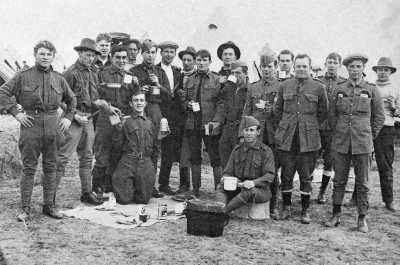
Like to copy this image? Please click here first
AWM A05741. Broadmeadows, Vic, 20 October 1914. New recruits to the AIF pause for a mug of tea during training in camp.
In an adjacent camp, within sight of the infantry soldiers, were the light horse regiments. Scotty noted with deepening interest the cocky swagger of the troopers and the spit and polish of their leather as they rode their Walers over the grassy paddocks.
Eventually, driven by envy and inspired by the sight that greeted him daily, Scotty applied for a transfer to the 4th Light Horse Regiment, which was designated as Divisional Cavalry. His request granted, Scotty became a member of a unit that saw itself as one of Victoria’s finest.
Bolton soon received his first taste of the grand overseas adventure for which he had volunteered. The 4th Light Horse went into training in a makeshift camp spread across the shifting sands of Egypt, in the shadows of the pyramids. Here the light horsemen sharpened their skills and refined that fighting prowess later to make them famous. In their off-duty hours the troopers indulged in the sights, sounds and various forms of entertainment that nearby Cairo had to offer.
No sooner had the sands of Egypt acquired a familiar feel than there was a stirring within the Division. The camp was awash with rumours of impending action. Stores were packed, orders were despatched, the soldiers were on the move. Just as the excitement reached fever pitch, the troopers of the light horse were told they were to remain in Egypt. Their disappointment was tangible. Irritated by the jeers of the departing infantry, Scotty pondered his decision to transfer to the light horse—had he relinquished his only chance of taking part in this war? Note 1. A Dream of the Past, Diary of Trooper Sloan Bolton DCM, privately printed by the family.
But the infantry had not faired well at Gallipoli and urgent reinforcements were needed. The light horsemen were to get their chance, but as infantry—the horses were unsuited to the terrain of the Gallipoli Peninsula so would stay behind in Egypt.
The 4th Light Horse landed in Gallipoli in early June 1915 and the troopers quickly realised that they had arrived on Hell’s doorstep. Scotty was to spend his first, but sleepless night at Gallipoli on the slopes of a place aptly named Dead Man’s Valley.Note 4 AWM 8, Unit Embarkation Nominal Rolls, 4th Light Horse Regiment AIF, 1914–1918 War.
Disease was rife amid the squalor of the ANZAC trenches, with a large proportion of casualties the victims of dysentery and diarrhoea, rather than the bullets fired by Johnny Turk. Characteristically loath to report sick, many soldiers attempted to hide their illness, others had to accept that evacuation to a hospital was the grim eventuality.
The ANZAC Diggers firmly believed that leaving the line was akin to deserting their mates. Bolton, almost crippled by disease, fought on until late August when he could barely stand and eventually had to be evacuated as far as the 2nd Australian General Hospital in Alexandria, Egypt. Two weeks later he was released from the hospital and sent to the reinforcement depot at Helouan on light duties.
The 4th left the Peninsula on 11 December 1914. Back in Egypt, as they licked their wounds, the troopers faced the grim reality that 41 of their own lay beneath the rugged landscape of Gallipoli.
Trooper Bolton rejoined his regiment on 2 January 1916, but the reunion was short-lived as Scotty was again stricken with disease—on 6 January he was readmitted to the hospital with mumps.
In early 1916, the 4th Light Horse was split to serve on two fronts. Two squadrons were despatched to fight the Hun on the Western Front, while Scotty and the other troopers remained in the Middle East—convinced they were destined to be held perpetually in reserve or used to perform odd jobs at the whim of the British High Command.
Disease and sickness, particularly malaria, continued to spread through the light horse ranks. Yet again, Scotty Bolton fell victim. On his release from the hospital, Scotty returned to find the Desert Mounted Corps had been engaged in successive, but unsuccessful, attacks on the Turkish bastion of Gaza. General Allenby, Commander-in-Chief of the forces in Palestine, now turned his attention to the nearby town of Beersheba.
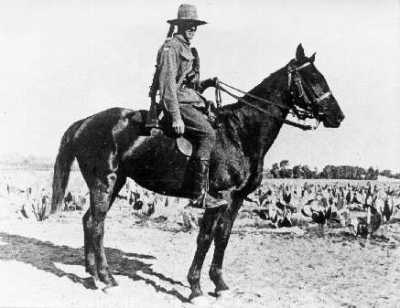
Bolton astride favourite mount, ‘Monty’. (Family collection)
The strategic value lay not only in its proximity to Gaza, but also in the huge wells within its precincts. (Water, as always, remained the currency of the Middle East. In the deserts of Palestine, wells were marked and valued in terms of the number of camels they could water. Some wells were marked as 100, some 1000, but the wells of Beersheba were marked as unlimited.) Note 5. Jones I, The Australian Light Horse, Time-Life Books Australia in association with John Ferguson, Sydney, 1987.
‘Z’ Day was scheduled for 31 October 1917. On the afternoon of the 28th, Bolton was among the crowds of troopers who stood before the canvas water troughs, urging their mounts to drink. Their desperation was fuelled by uncertainty—the next source of water was by no means assured and might be more than a day’s ride away. Note 1. A Dream of the Past, Diary of Trooper Sloan Bolton DCM, privately printed by the family.
The Commanding Officer of the 4th, Lieutenant Colonel ‘Swagman Bill’ Bourchier, screwed up his orders. Clutching the crumpled paper in his hand, he scowled at his officers. It seemed the 4th was designated reserve yet again.
In the cool, clear night, the lines of horsemen, four abreast, moved out. The snakelike column of regiment behind regiment extended for more than 16 kilometres. They rode all that night and into the next day. When they finally came to a grinding halt, the engineers moved out to assemble the watering troughs. They stopped in their tracks as the order came to mount up again. The troopers’ angst increased as they forced their thirsty horses on through the night.

Like to copy this image? Please click here first
AWM ART09557. H Septimus Power, Leaders of the Australian Light Horse in Palestine, 1918, 1926, Painting: oil on canvas, 152.2 x 243.6 cm.
Dawn on the morning of the 31st found them surveying a bare plain about four kilometres across. Beersheba glimmered, a veritable treasure trove, shining in the early morning sunlight. Like all hoards of riches, however, Beersheba was well guarded—two fortified hills, bristling with strong points, covered the approaches to the town.
Any attack against Beersheba was precluded by the dangerous necessity to secure these two hills. Tel el Saba would be attacked by the New Zealanders, while Tel el Sakati would be the 2nd Light Horse Brigade’s objective. The remainder of the horsemen would have to sweat out the day in a dust-filled wadi beneath the blazing sun of Palestine.
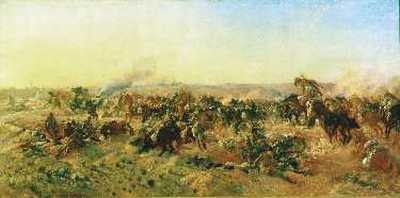
Like to copy this image? Please click here first
AWM ART02811. George Lambert, The charge of the Australian Light Horse at Beersheba, 1917, 1920, Painting: oil on canvas, 122.7 x 247.1 cm. Depicts the men and horses of the 4th Australian Light Horse Brigade encountering Turkish trenches and defending Turkish soldiers. A tangled mass of wounded and dying horses and soldiers is shown against the backdrop of a barren and undulating landscape. The buildings of Beersheba are just visible to the left on the horizon.
The battle for the guardian hills ebbed and flowed throughout the afternoon in a vicious cycle of hand-to-hand combat. By late afternoon the entire plan hung precariously in the balance. If Beersheba could not be taken soon, the action would have to be abandoned. Some horses had been without water for more than 60 hours and it was 12 hours’ ride to the next well capable of watering the force.
The commander of the Desert Mounted Corps, the legendary Lieutenant General Sir Harry Chauvel, assembled his commanders on the hill overlooking the stark plain. Together they dissected the situation, looking for answers. The commander of the 4th Light Horse Brigade, Brigadier William Grant, boldly proposed an audacious plan that boasted as its coup de main a massive cavalry charge.
Two regiments, the 4th and the 12th would thunder across the plain and charge the city. Chauvel pondered the situation for a moment. The time was now 4 pm and the sun would set at 4.50. With a furrowed brow, he gave his assent. Note 5. Jones I, The Australian Light Horse, Time-Life Books Australia in association with John Ferguson, Sydney, 1987.
While Grant and his commanders looked for an area to form up for the charge, the regimental sergeant major galloped along the wadi calling his men to prepare for action. Bolton tightened the girth on his horse, took a final gulp of water from his bottle and mounted. The regiments moved out into a patch of dead ground on the plain. With mounting astonishment mixed with feverish excitement, the troopers realised that they were about to attempt one of the great cavalry charges of modern times—an attack on Beersheba.
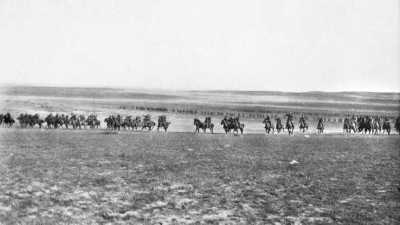
Like to copy this image? Please click here first
AWM A02684. ‘Thunder of a Light Horse charge’. The charge of the 4th Light Horse Brigade at Beersheba on 31 October 1917, taken by a Turk whose camera was captured later in the day.
The 4th Light Horse formed up on the right, with the 12th on the left. The 11th was still attempting to reach the plain and would form the depth regiment, if it arrived in time. Bourchier would lead both regiments in this eleventh hour bid. Facing the 800 horsemen were 4400 soldiers, supported by 28 field guns and a deadly mass of machine-guns.

Bourchier glanced at his watch, the time had come. He raised his arm above his head and waved it forward in one slow, deliberate motion. The horses stepped off. He gave the signal for the trot, then two minutes later, the canter.
In the presumed safety of their trenches, the German non-commissioned officers calmly gave their orders to the Turkish soldiers. Being familiar with the light horse tactics, they ordered their soldiers to wait until the light horsemen dismounted before opening fire.
At a distance of two and a half kilometres from the forward trenches, Bourchier commanded his men to charge. The steady canter of the horsemen reached the crescendo of the gallop and, hooves thundering, they bore down mercilessly on their hapless foe in a deadly, destructive wave.
As the horsemen surged forward, the Turkish batteries opened fire with a mixture of shrapnel and high explosive. The projectiles burst among the forward ranks. Men were blown from their saddles and some horses fell, but the charge did not falter. The Turkish gunners watched the charge, lowering the barrels of their guns, waiting for the dismount that never came. Suddenly the Light Horse regiments were below the trajectory of the guns. Note 5. Jones I, The Australian Light Horse, Time-Life Books Australia in association with John Ferguson, Sydney, 1987.
Pushing his Waler at full gallop, Trooper Bolton reached down and grasped the handle of his bayonet, extracting the 18-inch blade from its scabbard. Note 1. A Dream of the Past, Diary of Trooper Sloan Bolton DCM, privately printed by the family.
The Turks now set their rifle sights to a range of 1600 metres as the riflemen and machine-gunners readied themselves. The volley of lead cut through the lines of horsemen, but the thirsty horses could smell the water—there was no stopping them.
Bolton’s horse, Monty, careered wildly and he fought hard to regain control of his plunging beast. He was later to find that a bullet had narrowly missed his own leg, hitting instead the pannikin hanging from the saddle. This had deflected the round, carving a 12-inch gouge along the horse’s rump. Note 1. A Dream of the Past, Diary of Trooper Sloan Bolton DCM, privately printed by the family.
The Turkish riflemen fired wildly at the approaching horde. At the sight of the rampaging Australians, some Turks threw down their weapons and ran towards the town, others chose to fight to the end. The defenders were ordered to save the guns and the Turkish horse teams galloped forward to salvage what they could.
The first wave of the light horse now reached the forward enemy line. As the horses leaped across the open trenches, many of the Turks crouched and thrust their rifles and bayonets upward to disembowel the horses in mid-flight. The remnants of the first wave carried on to engage the support trenches. The scene had become a bloody shambles of rifle and revolver fire. The rip and slash of wielded bayonets punctuated the air and one horse was seen to join the fight, rearing and striking out with its fore-hooves. Note 5. Jones I, The Australian Light Horse, Time-Life Books Australia in association with John Ferguson, Sydney, 1987.
Scotty galloped through to the second line, attacking two Turks with his bayonet. As he rode towards the centre of town, he spotted a Turkish soldier running towards a house. Galloping over, Bolton kicked the Turk, forcing him to the ground, retrieving his revolver as he lay dazed. Note 1. A Dream of the Past, Diary of Trooper Sloan Bolton DCM, privately printed by the family.
Elements of the 12th Light Horse were already weaving their way through the streets, and some were watering their horses in the captured wells. One trooper fell to his knees in a Turkish canvas water trough, and drank side-by-side with his horse. Note 5. Jones I, The Australian Light Horse, Time-Life Books Australia in association with John Ferguson, Sydney, 1987.
Suddenly a well exploded, then another and yet another, the last blast almost throwing Bolton from his horse. On the ground he noticed a number of wires leading to a building. Bolton peered through an open window and caught sight of a German officer operating a switchboard. He sprang from the saddle and burst through the door. The startled German tightened his grip on the detonation handle. Bolton cocked his revolver and put it to the German’s forehead, overcoming the language barrier with one decisive stroke. Bolton’s mate, Trooper Ray Hudson, came through the door and took charge of the prisoner.1 Although some wells had been destroyed and a few had been damaged, most were still intact, including reservoirs holding more than 400000 litres. Note 5. Jones I, The Australian Light Horse, Time-Life Books Australia in association with John Ferguson, Sydney, 1987.

The author (R) outside the old Governor’s residence, Beersheba. It is believed that it was in the basement of this building that Bolton captured the German demolition officer. (Author’s collection)
Darkness was now settling over the captured town. Scotty emerged from the building into the growing dusk and remounted. A sudden movement caught his eye and, turning in his saddle, he saw a Turkish field gun and its six-man detachment, led by a German officer, galloping away from the town.
Digging his spurs into the Waler’s side, he set off in pursuit of the gun, calling for help from an Australian officer who was dismounted nearby. He rode up alongside the German officer and called for him to halt, but was ignored. Scotty took aim, pulled the trigger and heard the click of the empty chamber.
He then moved in closer and hit the German over the head, but, as the German was wearing a helmet, this did no more than hurt Bolton’s hand and dent his pride. Next he thrust the butt of the revolver in the German’s face, knocking him to the ground. Grabbing the reins of the lead horse, he slowed the team to a halt. Maintaining his bluff, he kept the Turks covered with the empty revolver, while the Australian officer rode up and took charge of the prisoners.
As they returned with their prize, retreating Turks threw down their weapons and joined Bolton’s party. By the time they reached the town square, their numbers had swelled to more than 30.1 For his actions, Scotty Bolton was awarded the Distinguished Conduct Medal, with a citation that hailed his conspicuous gallantry and devotion to duty. Note 6. AWM 28, Recommendation Files for Honours and Awards, AIF, 1914–1918 War.
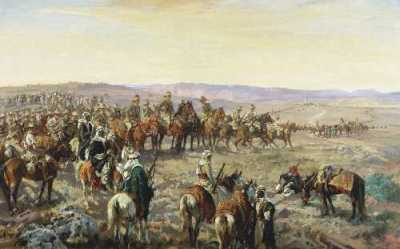
Like to copy this image? Please click here first
AWM ART12673. H Septimus Power, Ziza, 1935, Painting: oil on canvas, 152.5 x 244 cm. Turkish soldiers, threatened by Arabs, seek refuge with ALH units before formally surrendering to them.
Despite the ferocity of the attack, the casualties suffered by both regiments were relatively light, with only 31 killed and 36 wounded, most as a result of the savage hand-to-hand combat in the trenches. Note 6. AWM 28, Recommendation Files for Honours and Awards, AIF, 1914–1918 War.
With the fall of Beersheba, the Desert Mounted Column forged its way across Palestine, the Turkish resistance crumbling in their wake. Gaza fell a week later, the River Jordan was crossed and Jerusalem captured.
After spending the first months of 1918 resting and training, in March and April, the 4th took part in raids against the towns of Amman and Es Salt. However, a number of natural fortresses denied victory to the troopers: Red Hill, Black Hill, and the most vital—Table Top.
Table Top was a myriad of rocky outcrops and sheer slopes. The light horsemen eyed the fortress with a steely resolve. The defenders were equally determined to fight them off. Bolton checked and rechecked his rifle and ammunition. He drew his bayonet from its scabbard and fitted it to the weapon, laying out his three Mills bombs on the edge of his pit. Mentally, he urged the enemy to counter attack, daring them to show their faces. Note 1. A Dream of the Past, Diary of Trooper Sloan Bolton DCM, privately printed by the family. Note 7. The Mills bomb was a heavy fragmentation grenade.
Earsplitting screams punctuated the deluge of rifle and machine-gun fire as the Turks attacked. The troopers returned fire but soon found their ammunition all but exhausted. The pins were pulled on the Mills bombs and these were hurled at the relentless attackers. When the bombs ran out, the troopers resorted to rocks, taking pot shots at the Turks with any projectile that came to hand. Finally, the attack faltered, and the Turks began to withdraw. Along the light horse line, the order came to pursue the retreating attackers.
Scotty needed no urging. As he scampered in pursuit, he was enveloped in the dust and smoke of a sudden explosion and found himself rolling wildly and blindly down the hill. He pushed himself up with one hand, only to fall again—his left leg was now a mangled, bloody mess.
Crawling to gain cover behind a rock, Bolton felt his life draining away with each pulse from his severed arteries as he called plaintively for a stretcher-bearer. While he waited, he tried to administer some sort of first aid, then he realised that his right leg was also severely injured. Scotty was sure that this was the end. As he lapsed into unconsciousness, he heard the reassuring voice of a mate. Note 1. A Dream of the Past, Diary of Trooper Sloan Bolton DCM, privately printed by the family.
For days Bolton hovered precariously between life and death. One cold, still morning, he opened his eyes to be greeted by a pretty Australian nursing sister. He was in a hospital in El Arish. As he surveyed his surroundings, he noticed the cage that encompassed the lower portion of his body. The nursing sister followed his eyes and the look on her face told him the grim truth. He had lost both his legs. Note 8. From family notes, graciously provided by Mrs Margaret Grant (née Bolton).
The troopship pulled into the Melbourne dock to the clamour of bands and the cheers of the waiting crowds. Slowly, the gathering fell silent as the hushed and shocked people parted to allow the long stream of wounded to file through. These men had left Australia young, fit and full of fight. Now they returned blinded and maimed—many lacking limbs. These soldiers now faced a new fight.
Scotty spent his convalescence at the Caulfield Repatriation Hospital.3 Here he was fitted with a pair of artificial limbs. The courage he had shown at Beersheba was apparent again as he gritted his teeth and took his first steps with his new legs. Time and again, he was faced by setbacks. His new limbs would rub on the raw skin, the stumps that were once his legs would break down, and gangrene would set in—more surgery to remove the damaged tissue, and back to square one, learning to walk with artificial legs.
One day, as Scotty faced the daily grind of his exercise regimen, a young wisp of a girl walked in to distribute gifts to the patients. Their eyes met and a smile came to Scotty’s face. Her name was Elsie and he realised they had met before he went on service overseas. The two had exchanged letters during that time, but had remained simply pen pals. As time passed they became inseparable, but Scotty was reluctant to consider the possibility of marriage until he had proven himself capable of walking again. He made a promise to himself and to her. He would fight to regain his mobility; he would not surrender, irrespective of how long it took. He would walk again. Note 1. A Dream of the Past, Diary of Trooper Sloan Bolton DCM, privately printed by the family.
Of the thirty amputees in the ward, Scotty was the only one to walk out. The others lacked Bolton’s determination, accepting life as a cripple—dependent on crutches or confined to a wheelchair.
Scotty made many return trips to the hospital, earning the praise of his doctors for his resolve to master his new limbs. On one occasion, he alighted from a tram in front of the hospital, misjudged the gutter, and sprawled on the ground in a helpless tangle. As he struggled to regain his feet, many of the passers-by looked on in disgust, believing him to be yet another drunken veteran. An officer came to his aid, helping him gently to his feet. Scotty noticed the crimson ribbon on the officer’s chest. The Good Samaritan was none other than Captain Rupert Moon VC. Note 1. A Dream of the Past, Diary of Trooper Sloan Bolton DCM, privately printed by the family.
On 20 March 1919, Bolton was discharged from the Australian Imperial Forces. Note 3. National Archives of Australia: B2455, WW1 Service Records, 858 Private Sloan Bolton.
In 1922, he finally married his beloved Elsie.

Scotty and his wife, Elsie. (Family collection)
The postwar years saw the Boltons settle on a property in the Geelong area. Scotty quickly became obsessed with producing the best possible breeds of cattle. At the centenary Melbourne Show of 1934, one of Scotty’s animals won the coveted trophy for champion Jersey bull, establishing the Bolton name at the forefront of the cattle industry.
The Depression years were difficult times for the vast majority of Australians, but especially hard for the Bolton family. Scotty’s health deteriorated and he was required to make regular trips to hospital for treatment. The old light horse qualities of resourcefulness and self-sacrifice endured, and Scotty battled through the worst of those terrible years, determined to provide the best for his family.
Scotty was adamant that all his children should be competent horsemen. A favourite family tale concerned Ruby, a troublesome pony that had provided many a bruising encounter for the young Bolton children, bucking each of them off in turn. Finally, in a fit of frustration, Scotty stumped his way over to the horse, grabbed the reins and hoisted himself into the saddle, determined to show the children how it should be done. Suddenly, Ruby bucked, sending Scotty tumbling to the ground. As he lay grinning stupidly at himself, he realised that the force of the fall had broken one of his artificial legs. The Bolton children would remind their father of his tangle with Ruby for years to come. Note 1. A Dream of the Past, Diary of Trooper Sloan Bolton DCM, privately printed by the family.
On Christmas Eve 1947, as families across Australia rushed to complete last-minute Christmas shopping and children dreamed of the gifts they would receive on Christmas morning, Sloan Bolton, the brave Beersheba charger, fought his last battle. He did not live to greet the dawn of Christmas Day, 1947.
Elsie Bolton now took up the challenge and held her family together, only to be dealt another blow six months after Scotty’s death. The Bolton homestead was all but destroyed by fire. Among the treasured possessions lost to the flames were the medals that had been awarded to Scotty.
Elsie wrote a heartfelt letter to the Repatriation Department, explaining the loss of the medals. She described particularly the sense of emptiness that the family would feel on ANZAC Day, when other school children displayed medals and ribbons earned by parents and grandparents and yet the children of a proud and decorated veteran such as Sloan Bolton would have none. But Elsie’s request for replacement medals was refused. Mindless bureaucracy had determined that these medals could not be provided once a soldier had died. Note 1. A Dream of the Past, Diary of Trooper Sloan Bolton DCM, privately printed by the family.
In 1970, during Queen Elizabeth’s visit to Australia, Bolton’s ten-year-old granddaughter, Jenny, wrote to the Queen and asked if she would intervene and have her grandfather’s medals reissued to the family. The Governor General replied to Jenny’s request on the Queen’s behalf and a replacement DCM was forwarded to the family.
Scotty Bolton’s story was brought to life on the silver screen in the 1987 film The Light Horsemen. Jon Blake, a well-known Australian actor with a very promising future, was chosen to portray Bolton. He visited Elsie and wrote to her on a number of occasions, keeping her advised of the film’s progress. It seemed, however, that fate had not finished with the Bolton family. At the completion of filming, Blake left the outback film set to return to Adelaide. En route, he was involved in a terrible car accident which left the young actor with severe, irreversible brain damage.
Scotty Bolton’s story highlights the courage, resourcefulness and true grit that typified the light horsemen. They were men who routinely faced impossible odds with a wry, laconic humour. They revelled in their reputation for salvaging the most unlikely victory in the face of certain defeat. The legendary cavalry charge at Beersheba now occupies a hallowed place in the annals of Australian legend. Yet Scotty’s story is also the seldom-told story of courage, sacrifice and fierce determination that epitomised the struggle of many soldiers in those hard post-war years. The fight of the crippled and often traumatised soldier and his family to rebuild a normal life is also a story that truly warrants telling.
Author's note. I would like to thank Scotty’s daughter, Margaret, for her valuable assistance in piecing together her father’s story. The insight provided by his diaries and the family photographs has helped recreate the spirit of Scotty and for that I owe her my deepest gratitude.
Notes
- A Dream of the Past, Diary of Trooper Sloan Bolton DCM, privately printed by the family.
- The ‘Waler’, the horse favoured by the light horsemen, was commonly used as a stock horse in NSW at the time. It was bred from a mixture of English thoroughbred, draught horse, Timor pony, Welsh pony and brumby and was noted for its incredible stamina and ability to survive long periods without water.
- National Archives of Australia: B2455, WW1 Service Records, 858 Private Sloan Bolton.
- AWM 8, Unit Embarkation Nominal Rolls, 4th Light Horse Regiment AIF, 1914–1918 War.
- Jones I, The Australian Light Horse, Time-Life Books Australia in association with John Ferguson, Sydney, 1987.
- AWM 28, Recommendation Files for Honours and Awards, AIF, 1914–1918 War.
- The Mills bomb was a heavy fragmentation grenade.
- From family notes, graciously provided by Mrs Margaret Grant (née Bolton).





